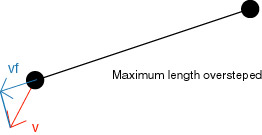Explicit integration methods :
the over-elongation problem
As with explicit methods, we cannot use high spring constants, cloth
fibres are over-elongated when submitted to external forces (see figure
below). To prevent this issue, we used some post-correction methods. These
methods intervene just after the integration step and work directly on
positons and/or velocities.
- Position correction:
The algorithm first checks the distances between spring . For over-elongated
springs (springs whose length is bigger than the maximum allowed),
it changes the node position as illustrated in the figure below. These
two steps are iteratively repeated until no over-elongated springs
remain. This algorithm, first proposed by ..., works well in simple
situations but fails when too many collisions occur between cloth
and other objects, because the method does not converge.
- Velocity correction:
Another approach is to correct the velocity of each node. We first
decompose the velocity into two components : the normal component
and the tangential component. In other words, suppose we have two
nodes linked by a spring. Only the velocity component projected on
the line passing through the two nodes is responsible for over-elongation.
The idea is to cancel this projected velocity when we find an overelongated
spring. Note that this correction is not physically correct, but our
main goal is to achieve a real-time cloth simulation with a correct
visual behaviour.




|














